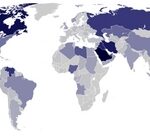The debate over whether Arctic National Wildlife Refuge needs to be opened for oil exploration continues to rage. It’s really been at the heart of a hot debate for quite some time now, and is gaining more attention due to increasing gas prices. Environmentalists are strongly against drilling in ANWR, based on the possible damage to the ecosystem. Many others feel that such fears are unfounded, and feel that the environmentalists are unreasonable. Like a lot of Americans, I have a lot of reservations about drilling in protected areas, but also feel that Americans shouldn’t be dependent on often-hostile countries for oil. I have no answers, but feel that either way, this is like closing the barn door after the horse is out.
ANWR was established in 1960 as the Arctic National Wildlife Range for conservation purposes. In 1980, it was renamed Arctic National Wildlife Refuge and its purpose was expanded, opening the way to possible oil and gas exploration on the northern coastal plain. This area, incidentally, hasn’t been designated as a wilderness area like most of the rest of the Refuge. Inupiat Eskimos and Gwich’in Indians own tribal lands in the area. Wildlife includes wolves, polar bears, caribou, snow geese, and Arctic grayling. This is definitely an interesting and important ecosystem in any case.
Advocates for oil drilling in this area frequently cite rising energy costs and our imported oil. They argue that the exploration and drilling would take place in a relatively small, non-wilderness area. In a 2003 speech, Secretary of the Interior Gale Norton estimated that the oil drawn from this area would surpass oil production in other U.S. states. Congressman Steve King (R-IA) pointed out the similarities to the ecosystem at Prudhoe Bay. Overwhelmingly, those in favor of ANWR drilling seem to feel that the impact would be low and the oil could be obtained in ways that don’t needlessly harm the environment.
Environmental groups, however, have some concerns that they feel are being ignored by advocates in favor of oil drilling. The National Resources Defense Council cites statistics saying that ANWR would only produce 1-2% of the daily oil consumption. NDRC is skeptical of claims that drilling would be restricted to a small area due to how oil is usually concentrated over a large area. The Sierra Club is concerned that oil would increase global warming and threaten species, including threatened polar bears.
I’m not a biologist or geologist, so I can’t accurately predict whether drilling in this area will cause minimal impact or if it will severely damage it. One thing, though, is that oil company executives and environmentalists do a lot of talking past each other. This happens so much that it’s no wonder these issues go unresolved. On one hand, we can’t harbor what I call a “trashed, thrashed, toasted Earth” mentality where we have no regard for the effects of our consumption. On the other hand, though, we can’t shut down or hinder oil production out of hand when alternatives are just in the fledgling stage.
Even if drilling in ANWR does turn out to be profitable, this is much like plugging up a hole in the wall with a sticker. We’ve known all along that fossil fuel isn’t renewable. Keep in mind that it’s mostly refined from the remains of organisms that died tens or hundreds of millions of years ago Rather than sitting around bickering with each other over whether we should or shouldn’t drill oil, we need to start working on finding renewable alternatives so that oil ceases to be as much of a problem. What will it take for us to come to this realization, short of literally finding ourselves in the dark?



